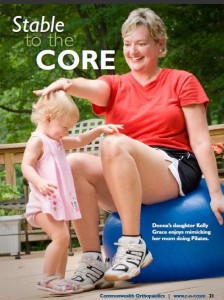 Donna was overjoyed when she gave birth to her “miracle baby”—Kelly Grace—last year.
Donna was overjoyed when she gave birth to her “miracle baby”—Kelly Grace—last year.
But shortly after her C-section, the 46-yearold software consultant from West Springfield began to experience pain in her right hip, which grew steadily worse over the next 12 months. Her family doctor referred her to Mark McMahon, MD, at Commonwealth Orthopaedics, who performed arthroscopic hip surgery in May.
Although the procedure relieved Donna’s pain, Dr. McMahon recommended post-operative physical therapy to strengthen her muscles and prevent the problem from recurring. For six weeks, she worked with Ann Wendel, PT, ATC, a physical therapist specially trained in core stabilization and Pilates at Commonwealth’s Springfield office.
“Core stabilization involves exercises for the deep abdominal muscles, trunk extensor muscles and deep muscles of the back that control rotational movement of the spine,” Wendel explains. “Donna’s pregnancy and C-section had weakened those muscles and made her especially vulnerable to low back and pelvic injuries.
Donna has regained flexibility and stamina as a result of core stabilization and Pilates at Commonwealth. We focused on a combination of flexibility, balance and hip strengthening exercises tohelp her return to her normal activities and quality of life.” Donna saw Wendel twice a week and practiced daily exercises at home. Her routine included basic moves such as walking sideways, pivoting and turning, and gradually putting more weight on her hip to strengthen it. “Chasing around after my daughter involves every kind of movement imaginable—walking, running, lifting her out of the tub. I never realized how much my core is involved in these simple moves and what a difference good abdominal strength would make in my daily life,” she says.
It also was beneficial to perform the exercises under the guidance of a physical therapist with extensive training in core stabilization and Pilates methods. Ann would observe Donna’s technique and make subtle changes to be sure she was performing each movement properly for maximum benefit.
This one-on-one supervision taught Donna the correct way to safely activate the deep muscles of her abdomen and spine to strengthen and stabilize her core. Small tweaks here and there made a big impact when she practiced the routine at home. Donna was equally impressed with the personal attention and care she received from everyone at Commonwealth Orthopaedics. “They took into consideration that I’m a busy, working mother and tailored the exercises to fit my schedule and give me the results I needed,” she says. Joseph Pilates first developed his core stabilization techniques in the 1920s to train and rehabilitate ballet dancers. Over the years, the method has gained popularity and Pilates is now part of the fitness mainstream both as a popular workout regime and rehabilitation program. The exercises retrain the deep muscles that stabilize the abdomen and spine, as well as the superficial muscle known as the rectus abdominus. Anyone can benefit from this type of conditioning, including those with hip or back pain, or whose muscles are weakened due to spine or abdominal injury or surgery. Athletes are also good candidates.“Proper core stabilization promotes balance and strength and helps prevent athletic injury,” says Frank Pettrone, MD, a Commonwealth Orthopaedics surgeon who works with local sports teams to advocate these prevention techniques. “It’s especially important in activities where you pivot or push off and are particularly prone to abdominal injuries. People don’t realize it all stems from the trunk. Core stabilization strengthens these muscles.”
For athletes who have suffered injuries, Dr. Pettrone often recommends core stretching and strengthening exercises to repair the body and return to the playing field. A typical routine begins with easy stretching, moves into a more intense stretching phase, adds resistance exercises and aggressive strengthening, and culminates with sports-specific training. After her therapy from Commonwealth, Donna not only has the flexibility and stamina to chase after her active and growing toddler, she’s also resumed one of her favorite activities—a monthly golf game with her husband. “Golf requires a strong core and I was able to get back on the course in July, just two months after my surgery, thanks to the professional and helpful folks at Commonwealth Orthopaedics,” she says. Commonwealth Orthopaedics | www.c-o-r.com 23
Mark R. McMahon, MD graduated with a BA from the University of Oregon and went on to earn his medical degree from Oregon Health Sciences University. Following a general surgery residency at the University of Oregon, he completed a year of orthopaedic research at Rancho Los Amigos Medical Center and then finished his orthopaedic training at the University of Southern California. Frank A. Pettrone, MD, earnied a BA from Brown University and a medical degree from Georgetown University. Dr. Pettrone completed both his internship and residency program at Georgetown University Medical Center. Then, before joining Commonwealth Orthopaedics, he served a tour in the United States Navy as an orthopaedic surgeon.
Ann Airey Wendel, PT, ATC, earned a B.S. in P.E. Studies with a concentration in Athletic Training from the University of Delaware, and a Masters in Physical Therapy from the University of Maryland, Baltimore. She is a Certified Athletic Trainer (ATC) licensed in Virginia, and a Licensed Physical Therapist.
This article was originally posted in Commonwealth Othopaedics company magazine.